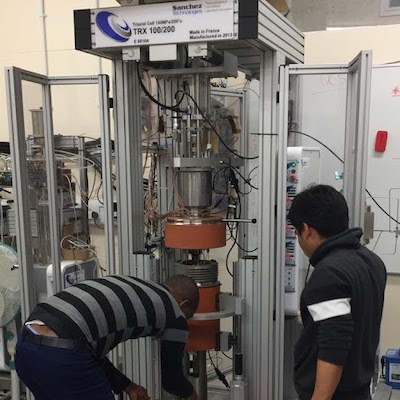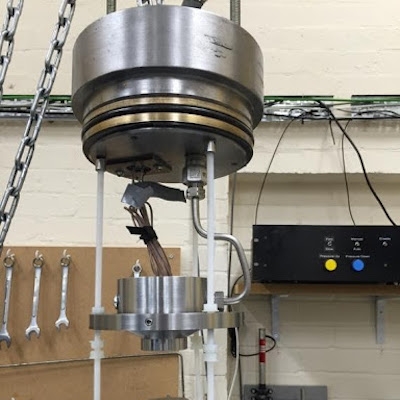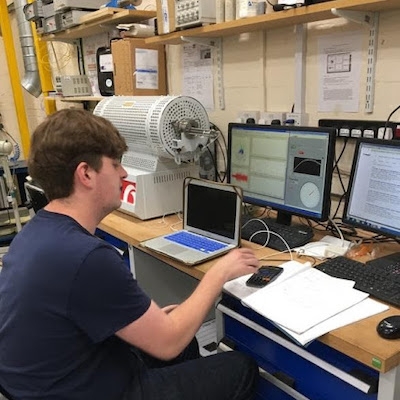The Rock Mechanics Laboratory (RML) uses the latest technology in high-pressure hydraulic apparatus, combined with high-speed acoustic sensors and instrumentation, to measure the properties of minerals and rocks under simulated geological stress conditions up to approximately 16 km depth.
Students using these facilities include those taking including MSc Engineering Geology and Geotechnics, and MSc Geological and Environmental Hazards. The laboratory also provides consultancy, data, measurements, training and project support to researchers across Earth sciences, geomechanics, applied physics, and mechanical/design engineering.
Our equipment is used to measure and quantify the strength/elasticity of rocks and minerals, fluid-flow permeability, rock and joint friction, induced seismicity, and to understand and asses the geological hazards of fluid-saturated rock masses such as volcanoes and geothermal systems.

The 100 Mpa rock physics apparatus being prepared for an experiment.

A sample assembly of the large bore hydrostatic pressure vessel.

A student operates the Carbolite furnace to simulate heat-induced fracturing.
Equipment & methods
-
Instron 60 tonne uniaxial press
Our 600kN uniaxial loading frame is equipped with ancillary pressure systems to provide confining pressure via a simple pressure (Hoek) cell. Force and strain are digitally logged, and a 2 channel Physical Acoustics PCI-2 AE setup allows fracturing to be measured. We perform strength testing to the ISRM standard for unconfined compressive strength, indirect tensile strength and chevron notched Brazilian disk fracture toughness methods. Sample preparation is supported by technical support in our adjacent rock coring and cutting room.
-
100 MPa Triaxial “rock physics” cell
Our state-of-the-art triaxial cell is the latest addition to the laboratory, equipped with instrumentation to measure dynamic permeability and elastic wave velocity at up to 4km simulated depths and up to 200°C. The maximum stress (across a 40 mm diameter) of 700 Mpa allows the deformation of most rock types in the shallow crust for basic research into earthquake and rock physics. Most recently we have developed a novel sample assembly to simulate hydraulic fracturing processes in the (controlled) laboratory environment.
-
ASC “Milne” and “Richter” advanced Acoustic Emission system
This state-of-the art Microseismic recorder (Applied Seismology Consultants) can measure 12 channels of data simultaneously, and locate the locations of the earthquakes in quasi-real time for display and analysis at data rate of up to 100 events/second. The instrument can also be used in active mode, ‘pinging’ successive sensors to generate a dense P-wave raypath network for comparing to field seismology in manner analogous to exploration seismology. The recorder is used during triaxial deformation experiments to investigate the fracturing and cracking processes due to applied stress and pore pressure.
-
Carbolite Furnace
Capable of 1200C and with a sealed tube this furnace may be used for thermally treating rock specimens to induce fracture (with AE recording) and/or monitoring gas emission.
-
400 MPa Large Bore “Harwood” Hydrostatic pressure vessel
This hydrostatic pressure vessel is one of three rock physics vessels that were acquired from the university of Wyoming where they were previously installed and used as the laboratory of David Fountain. The largest of these can accommodate samples of 100mm diameter and 250mm length up to pressures of 400 MPa (approximately 16 km). The sample assembly is equipped with P-wave and S-wave transducers for measuring elastic wave velocity and is plumbed for the application of pore fluid/pressure.
-
Controls shear boxes
We have two digitally logged hydraulic shear box for the testing of rock shear strength (pulverised rocks, granular specimens, or intact rock joints) samples up to 11.5 x 12.5 cm.
Laboratory contacts
- Dr. Philip Benson (Laboratory director; Geophysics, Seismology, and Rock Physics)
- Emily Butcher (Technician)
- Dr. Nick Koor (Engineering geology & Geotechnics)
- Dr. Carmen Solana (Physical volcanology & seismology)
